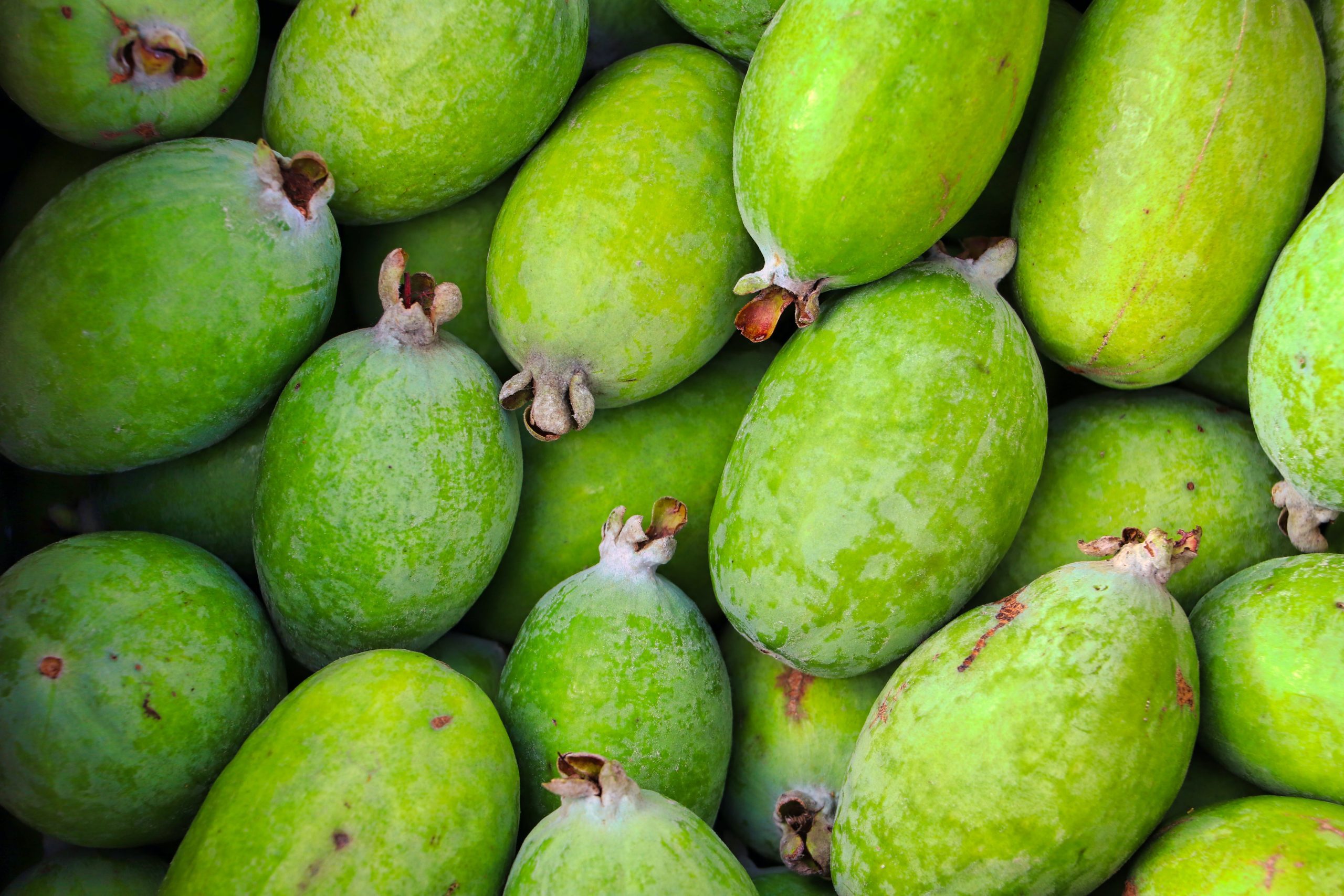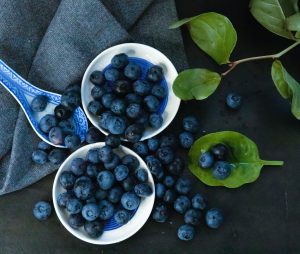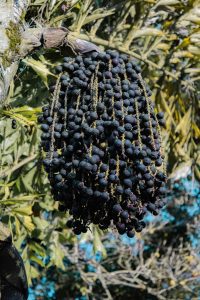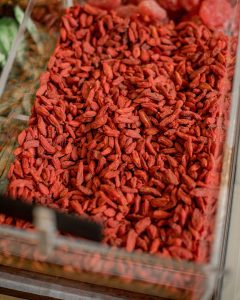
What Is a Feijoa?
A feijoa, scientifically known as Acca sellowiana, is a unique and flavorful fruit native to South America, particularly Brazil, Uruguay, and Argentina. Also called pineapple guava or guavasteen, the feijoa is recognized for its distinctive taste, combining flavors reminiscent of pineapple, guava, and mint. The fruit is oval-shaped, with a green, slightly rough skin that encases a sweet and aromatic, jelly-like pulp filled with tiny, edible seeds.
Feijoas are rich in essential nutrients, including vitamin C, dietary fiber, and antioxidants. They are enjoyed both fresh and in various culinary creations such as jams, chutneys, desserts, and beverages. The aromatic and tropical essence of feijoas makes them a sought-after addition to fruit salads and a flavorful ingredient in smoothies and cocktails. With a growing presence in different regions globally, feijoas are celebrated for their unique taste and nutritional benefits.
Why Do We Eat Feijoas?
People eat feijoas for several reasons, driven by their unique flavor, nutritional benefits, and versatility in culinary applications:
- Distinctive Flavor:
- Feijoas have a unique taste that combines notes of pineapple, guava, and mint. This distinctive flavor makes them appealing for those seeking a refreshing and exotic fruit experience.
- Rich in Nutrients:
- Feijoas are a good source of essential nutrients, including vitamin C, dietary fiber, and antioxidants. These components contribute to overall health and well-being.
- Versatility in Culinary Use:
- Feijoas can be used in a variety of culinary applications. They are enjoyed fresh on their own, added to fruit salads, or incorporated into recipes for jams, chutneys, desserts, and beverages.
- Desserts and Baking:
- The sweet and aromatic nature of feijoas makes them a popular ingredient in desserts, such as pies, tarts, cakes, and muffins. Their flavor adds a tropical twist to baked goods.
- Jams and Preserves:
- Feijoas are commonly used to make jams, preserves, and chutneys. These products allow the unique flavor of feijoas to be preserved and enjoyed throughout the year.
- Smoothies and Beverages:
- Feijoas can be blended into smoothies or used as a flavorful addition to beverages. Their tropical taste enhances the overall profile of these drinks.
- Salads:
- Feijoas add a burst of flavor to fruit salads, green salads, and side dishes. Their aromatic qualities make them a delightful and unexpected addition to various salads.
- Culinary Creativity:
- Chefs and home cooks appreciate feijoas for their versatility, allowing them to experiment with different flavor combinations in both sweet and savory dishes.
- Natural Snacking:
- Feijoas are enjoyed as a healthy and refreshing snack. Their unique taste and juicy texture make them a satisfying option for those looking for natural, whole-food snacks.
In summary, the consumption of feijoas is driven by their appealing taste, nutritional richness, and adaptability in various culinary creations, making them a flavorful and versatile fruit enjoyed in a variety of ways.
When Do We Eat Feijoas?
Feijoas are typically consumed during their peak season, which varies depending on the region. The general harvest period for feijoas is from late autumn to early winter. The specific months can vary, but it is commonly from April to June in the Southern Hemisphere, where the fruit is more prevalent.
Here are some occasions and times when people often enjoy feijoas:
- Fresh Harvest Season:
- Feijoas are best enjoyed when they are in season and freshly harvested. During this time, the fruit is at its peak flavor, aroma, and nutritional content.
- Casual Snacking:
- Feijoas can be eaten casually as a refreshing and healthy snack. Simply cut the fruit in half and scoop out the flavorful pulp with a spoon.
- Breakfast:
- Feijoas can be sliced and added to breakfast options like cereal, yogurt, or oatmeal. They provide a tropical and aromatic addition to morning meals.
- Desserts:
- Incorporate feijoas into desserts such as pies, tarts, cakes, and muffins. Their sweet and aromatic profile enhances the overall taste of these treats.
- Jams and Preserves:
- Feijoas are often used to make jams, preserves, and chutneys. These products allow the unique flavor of feijoas to be enjoyed beyond the harvest season.
- Smoothies and Beverages:
- Blend feijoas into smoothies for a refreshing and exotic twist. They can also be juiced or used as a flavorful addition to various beverages.
- Salads:
- Add feijoas to fruit salads or green salads to provide a burst of tropical flavor. Their unique taste complements a variety of salad ingredients.
- Culinary Creativity:
- Feijoas can be incorporated into various culinary creations, including savory dishes, sauces, and marinades. Chefs and home cooks often experiment with feijoas in creative recipes.
It’s important to note that the availability of feijoas can vary by location, and in some areas, they may be imported or available year-round in stores. The specific time for enjoying feijoas depends on local growing conditions and harvesting practices.
Ingredients of Feijoas
Feijoas, being a natural fruit, consist of various components that contribute to their unique flavor and nutritional profile. Here are the main elements found in feijoas:
- Water:
- Feijoas have a high water content, contributing to their juiciness and refreshing nature.
- Natural Sugars:
- Feijoas contain natural sugars, including fructose, which provide their characteristic sweet and aromatic taste.
- Vitamins:
- Feijoas are a good source of vitamin C, an antioxidant that supports the immune system. They also contain smaller amounts of other vitamins, such as vitamin K.
- Dietary Fiber:
- Feijoas provide dietary fiber, which promotes digestive health and contributes to a feeling of fullness.
- Antioxidants:
- Feijoas contain antioxidants, including polyphenols, which help combat oxidative stress in the body.
- Minerals:
- Feijoas provide minerals like potassium, which is essential for maintaining proper fluid balance and supporting heart health.
- Flavor Compounds:
- Feijoas contain a variety of flavor compounds that contribute to their unique taste, combining notes of pineapple, guava, and mint.
It’s important to note that the specific nutritional content can vary slightly depending on factors such as the size and variety of the feijoa. Consuming feijoas in their natural state allows you to benefit from their nutritious components without any additional ingredients.
Types of Feijoas
Feijoas, also known as pineapple guavas, come in several varieties, each with its own unique characteristics in terms of flavor, size, and growing conditions. Here are some common types of feijoas:
- Apollo Feijoa:
- Known for its large size and sweet, aromatic flavor, the Apollo feijoa is a popular cultivar. It has a smooth skin and is often grown in various regions.
- Mammoth Feijoa:
- As the name suggests, Mammoth feijoas are larger in size compared to other varieties. They have a sweet taste and are recognized for their impressive fruit size.
- Gemini Feijoa:
- Gemini feijoas are valued for their sweet and juicy flavor. They are often medium-sized and have a pleasant aromatic quality.
- Unique Feijoa:
- Unique feijoas are known for their elongated shape and distinct flavor. They are sweet and aromatic, making them a favorite among feijoa enthusiasts.
- Nazemetz Feijoa:
- Nazemetz feijoas are prized for their sweet and tangy taste. They are medium to large in size and have a unique flavor profile.
- Coolidge Feijoa:
- Coolidge feijoas are recognized for their sweet and aromatic taste. They are medium-sized and have a smooth skin.
- Wiki Tu Feijoa:
- Wiki Tu feijoas are known for their flavorful and aromatic qualities. They are medium to large in size and have a distinct taste.
- Triumph Feijoa:
- Triumph feijoas are characterized by their sweet and aromatic flavor. They are medium to large and have a smooth skin.
- Apollo’s Triumph Feijoa:
- This variety is a hybrid of the Apollo and Triumph feijoas. It combines the desirable traits of both, offering a sweet and aromatic taste.
- Edenvale Improved Feijoa:
- Edenvale Improved feijoas are recognized for their improved flavor profile. They are sweet and aromatic, making them a popular choice.
It’s important to note that feijoa varieties may be named differently in various regions, and availability can vary depending on local cultivation practices. Each feijoa variety offers a unique taste and texture, making them a versatile and enjoyable fruit for various culinary uses.
Signs of Ripe, Signs of Raw and Signs of Rotten Feijoas
Signs of Ripe Feijoas:
- Aroma:
- Ripe feijoas have a sweet and fragrant aroma, especially when you cut or smell the fruit near the stem end.
- Color:
- The skin of ripe feijoas turns slightly yellowish-green or green. However, the specific color can vary based on the variety.
- Slight Yield to Pressure:
- When gently pressed, ripe feijoas should give slightly, indicating that they are soft and ready to eat.
- Smooth Skin:
- Ripe feijoas have a smooth skin without wrinkles or blemishes.
- Easy Separation from Tree:
- Feijoas are usually ready to harvest when they easily detach from the tree with a gentle twist.
Signs of Raw or Unripe Feijoas:
- Firmness:
- Unripe feijoas feel firm to the touch and lack the slight give that ripe ones have.
- Green Color:
- Unripe feijoas typically have a predominantly green color, and the skin may be firmer and less aromatic.
- Tart Taste:
- Unripe feijoas can taste more tart and less sweet than their ripe counterparts.
- Wrinkled Skin:
- If the feijoa’s skin is wrinkled or puckered, it may indicate that it is not fully mature.
Signs of Rotten Feijoas:
- Foul Odor:
- Rotten feijoas emit a foul or unpleasant smell, signaling decay.
- Soft or Mushy Texture:
- Rotten feijoas will feel soft or mushy to the touch, and pressing on them may result in a noticeable indentation.
- Discoloration:
- Dark or off-color patches on the skin or flesh indicate spoilage.
- Visible Mold:
- If there is visible mold on the feijoas, it is a clear sign of decay.
- Leaking Liquid:
- Any liquid oozing from the feijoas is a sign of internal breakdown and spoilage.
When selecting feijoas, choose those with a sweet aroma, a slightly yielding texture, and smooth skin. Avoid feijoas that are excessively firm, green, or show signs of rot. Proper storage can help extend the shelf life of ripe feijoas.
Summary
Feijoas, also known as pineapple guavas, are a distinctive and flavorful fruit native to South America, particularly Brazil, Uruguay, and Argentina. Recognized for their unique taste, combining notes of pineapple, guava, and mint, feijoas have become popular for their culinary versatility and potential health benefits.
Key Points:
- Flavor Profile: Feijoas have a sweet and aromatic flavor with a unique blend of tropical and minty notes.
- Appearance:
- The fruit is oval-shaped, with a green, slightly rough skin, encasing a sweet, jelly-like pulp filled with tiny, edible seeds.
- Nutritional Content:
- Feijoas are rich in essential nutrients, including vitamin C, dietary fiber, antioxidants, and minerals.
- Culinary Uses:
- Feijoas are enjoyed fresh, added to fruit salads, and used in various culinary creations, including jams, chutneys, desserts, and beverages.
- Harvest Season:
- Feijoas are typically harvested in late autumn to early winter, with specific months varying by region.
- Ripeness Signs:
- Ripe feijoas are identified by a sweet aroma, a slight yield to pressure, smooth skin, and a yellowish-green color. Unripe feijoas are firm, green, and lack the sweet aroma.
- Avoiding Spoilage:
- Signs of rotten feijoas include a foul odor, soft or mushy texture, discoloration, visible mold, and leaking liquid.
Overall, feijoas are celebrated for their unique taste, nutritional richness, and versatility in both sweet and savory culinary applications, making them a sought-after and enjoyable fruit.






